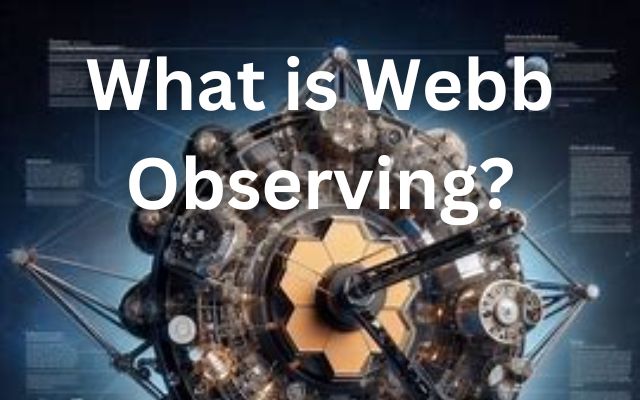What is Webb Observing?
“Explore the universe with What is Webb Observing?. Uncover its science, significant discoveries, and future in our detailed guide.”

“What is Webb Observing?” is a question that has sparked the curiosity of many. Webb Observing refers to the scientific observations made by the James Webb Space Telescope (JWST), a marvel of modern technology. This telescope, named after former NASA administrator James E. Webb, is designed to observe the universe in unprecedented detail.
From peering into the farthest reaches of space to uncovering the mysteries of exoplanets, Webb Observing is revolutionizing our understanding of the cosmos. This article aims to delve into the intricacies of Webb Observing, shedding light on its significance, the science behind it, and the remarkable discoveries it has facilitated. Join us as we embark on this fascinating journey of exploration and discovery.
What is Webb Observing?
Webb Observing is a term that refers to the scientific observations made by the James Webb Space Telescope (JWST), one of the most advanced astronomical observatories ever built. Named after former NASA administrator James E. Webb, the JWST is designed to observe the universe in unprecedented detail.
The JWST started transmitting data back in 2022, and since then, it has made several significant discoveries. For instance, it has revealed new features in the heart of the Milky Way, including never-before-seen features astronomers have yet to explain. The telescope has also found evidence for the first stars that brought light to the universe.
The JWST’s observations are not limited to distant galaxies and stars. It also studies exoplanets, helping scientists understand the conditions that might exist on these distant worlds.
In addition to its current observations, the JWST has a busy schedule ahead. A total of 253 General Observers (GO) programs have been selected, dedicating over 5,500 hours to exploring various cosmic phenomena from July 2024 to June 2025. These programs aim to expand upon the scientific achievements made since the JWST started transmitting data.
Webb Observing is not just about collecting data; it’s about understanding our place in the universe. By studying the cosmos, we can learn more about the origins of our own planet and the potential for life elsewhere in the universe.
In conclusion, Webb Observing is a revolutionary practice that is expanding our knowledge of the universe. With each new observation, we gain a deeper understanding of the cosmos and our place within it…
The Science Behind Webb Observing
Webb Observing is made possible by the James Webb Space Telescope (JWST), a marvel of modern technology that observes the universe in the infrared spectrum. This capability allows the JWST to see through dust and gas that block visible light, revealing the hidden universe to our eyes.
The JWST has the high resolution of the Hubble Space Telescope and the ability to detect light wavelengths into the mid-infrared range, like the Spitzer Space Telescope. This combination of high resolution and infrared detection allows the JWST to observe phenomena that were previously inaccessible.
One of the key technologies enabling Webb Observing is the JWST’s infrared detectors. These detectors collect the faint light coming from distant stars and galaxies, more than 13 billion light-years away. The light from these early galaxies is stretched into the infrared part of the electromagnetic spectrum due to the so-called redshift.
Another crucial component of the JWST is its Earth-pointing antenna, which sends science data back to earth and receives commands from NASA’s Deep Space Network. The solar array, always facing the sun, converts sunlight to electricity to power the Observatory.
Webb Observing is not just about the technology; it’s also about the science. The JWST is designed to explore key areas of astronomy, including the early universe and exoplanets. By studying these areas, scientists hope to discover secrets of the universe and search for life beyond Earth.
In conclusion, the science behind Webb Observing is a combination of advanced technology and ambitious scientific goals. With each new observation, we gain a deeper understanding of the cosmos and our place within it.
Discoveries Made Through Webb Observing
Webb Observing, facilitated by the James Webb Space Telescope (JWST), has led to numerous groundbreaking discoveries that have significantly advanced our understanding of the universe.
One of the most notable discoveries is the detection of methane and carbon dioxide in the atmosphere of an exoplanet named K2-18 b. This finding supports the hypothesis that there may be a water ocean underneath a hydrogen-rich atmosphere on K2-18 b.
The JWST has also provided the most detailed infrared image of the universe ever created. This deep field image has allowed scientists to observe the universe like never before.
In addition to these, the JWST has made several other significant discoveries. These include the detection of the earliest complex organic molecules, splendid views of Saturn, revealing Jupiter’s almost invisible rings, and a sneak peek into the Tarantula Nebula.
Moreover, the JWST has observed the most distant active supermassive black hole and the first filaments of the cosmic web. These observations have provided invaluable insights into the early universe and the large-scale structure of the cosmos.
The JWST’s observations have not only expanded our knowledge of the universe but also sparked worldwide excitement. People around the world are sharing its images and generating new insights by manipulating raw information.
In conclusion, Webb Observing has led to a series of remarkable discoveries that have revolutionized our understanding of the universe. With each new observation, we gain a deeper understanding of the cosmos and our place within it.
The Future of Webb Observing
The future of Webb Observing is as exciting as its present. The James Webb Space Telescope (JWST) has a busy schedule ahead with a total of 253 General Observers (GO) programs selected, dedicating over 5,500 hours to exploring various cosmic phenomena from July 2024 to June 2025.
These programs aim to expand upon the scientific achievements made since the JWST started transmitting data back in 2022. The exploration will cover a broad spectrum of celestial subjects, including potential exomoons, exoplanets alongside their atmospheres, supermassive black holes, and distant galaxies from the universe’s nascent stages.
Among the notable projects, Columbia University’s Assistant Professor David Kipping and his team will investigate extra-solar moons, specifically targeting the exoplanet Kepler-167e. This marks a significant step forward in the hunt for exomoons, leveraging JWST’s Near Infrared Imager and Slitless Spectrograph (NIRISS) for potentially the first undisputed detection of an exomoon.
Furthermore, the JWST’s Cycle 3 will delve into the enigmatic realm of supermassive black holes situated at the heart of major galaxies, contributing vital data to our understanding of these cosmic giants and their impact on galaxy evolution.
In addition to its deep space missions, the JWST will also embark on studies within our solar system, including the analysis of gas plumes from Saturn’s moon Enceladus and the dynamics of Uranus’ rings.
The Cycle 4 call for proposals is set to open on August 1, 2024, marking the next phase of this groundbreaking astronomical endeavor. With each new observation, we gain a deeper understanding of the cosmos and our place within it.
- Tech Tips for Online Learning: How to Optimize Your Virtual Classroom
- Laptop Pro Tips: Delete Shortcut Keys in a laptop
- Android 14 Hidden Features and Tips You Should Know
FAQ
1. What is James Webb observing?
The James Webb Space Telescope (JWST) is observing a wide range of astronomical phenomena. It’s designed to study every phase in the history of our Universe, from the first luminous glows after the Big Bang to the formation of solar systems capable of supporting life.
2. What can Webb see?
Webb is optimized to observe infrared light, which allows it to see details in the universe and determine the composition of distant objects, from exoplanets to galaxies. It can detect and characterize fully-formed planets, planets in the process of forming, and proto-planetary disks orbiting other stars in the Milky Way.
3. What will the Webb tell us?
Webb will provide insights into the origins of the universe and our place in it. It will help us understand the diversity of galaxy composition and structure over space and time, how galaxies form, interact, and change, and how supermassive black holes and their host galaxies influence each other. It will also study the earliest galaxies and supernovae produced by the universe’s first stars.
4. What is the concept of Webb telescope?
The James Webb Space Telescope is the largest, most powerful space telescope ever built. It’s designed to look deeper into space to see the earliest stars and galaxies that formed in the universe and to look deep into nearby dust clouds to study the formation of stars and planets.
5. How far back can Webb see?
Webb can look further back in time than any other telescope, observing distant stars and galaxies as they appeared 13.5 billion years ago, not long after the beginning of the universe as we know it.
6. How old do scientists think the universe is?
Scientists estimate that the universe is approximately 13.8 billion years old.
7. How many light years away can James Webb see?
The James Webb Space Telescope can see more than 13 billion light years into space.
8. How long will James Webb last?
Initially, Webb’s mission lifetime was projected to be at least 5-1/2 years. However, after the successful launch of the telescope, NASA found that the observatory has enough propellant (fuel) to support scientific operations for more than 10 years.
9. What telescope can see Earth?
The Hubble Space Telescope, a large space telescope orbiting Earth, can see space better than telescopes on Earth can…
Conclusion
Webb Observing, facilitated by the James Webb Space Telescope (JWST), has revolutionized our understanding of the universe. From unveiling the mysteries of distant galaxies to probing the atmospheres of exoplanets, Webb Observing has provided us with unprecedented insights into the cosmos.
The future of Webb Observing is promising, with numerous exciting projects lined up. These projects aim to further expand our knowledge of the universe and potentially uncover signs of life beyond Earth.
In conclusion, Webb Observing is a testament to human curiosity and our relentless pursuit of knowledge. As we continue to observe the universe through the eyes of the JWST, we can look forward to many more groundbreaking discoveries that will deepen our understanding of the cosmos and our place within it.
The journey of exploration and discovery continues, and we are just at the beginning. The universe is vast, and there is so much more to learn.






